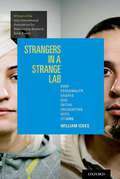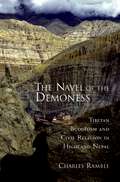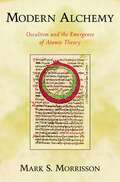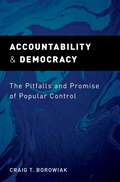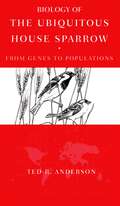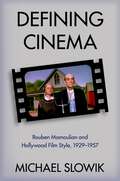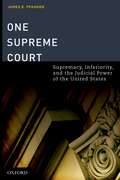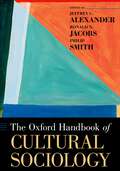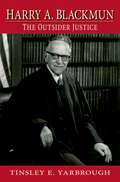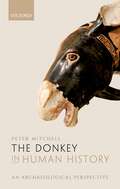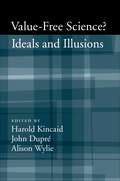- Table View
- List View
The Oxford Handbook of Intellectual Disability and Development (Oxford Library of Psychology)
Though the tremendous amount of recently-emerged developmentally-oriented research has produced much progress in understanding the personality, social, and emotional characteristics of persons with intellectual disabilities (ID), there is still much we don't know, and the vast task of precisely charting functioning in all these areas, while also identifying the associated fine-tuned, complex, and intertwined questions that crop up along the way, seems daunting and insurmountable. The goal of The Oxford Handbook of Intellectual Disability and Development is to update the field with new, precise research and sophisticated theory regarding individuals with ID provided by seasoned developmental theorists who have made original conceptual contributions to the field. This volume is divided into five general sections (ID and its connection to genetics, relationships, cognitive development, socio-emotional development, and development of language), with each focused on a domain of functioning or aspect of life that is inherent to an integrated, transactional perspective of development. While developmental approaches to understanding persons with intellectual disability will continue to emerge, this comprehensive volume is a must-read for specialists and developmental psychologists who must have the conceptual foundations for examining the developmental trajectories across persons with any of the many different ID etiologies.
Strangers in a Strange Lab: How Personality Shapes Our Initial Encounters with Others
by William IckesBWinner of the 2012 International Association for Relationship Research Book Award/B Can we predict how well -- or how poorly -- two strangers will get along? According to social psychologist William Ickes, the answer is yes. Drawing upon relevant research findings from his 30-year career, Ickes explains how initial interactions are shaped by gender, race, birth order, physical attractiveness, androgyny, the Big Five dimensions, shyness, and self-monitoring. Ickes's work offers unprecedented insights on the links between personality and social behavior that have not previously been compiled in a single source: how sibling relationships during childhood affect our interactions with opposite-sex strangers years later; why Latinos have a social advantage in initial interactions; how men react to the physical attractiveness of a female stranger in a relatively direct and obvious way while women react to the attractiveness of a male stranger in a more indirect and subtle way; and how personality similarity is related to satisfaction in married couples.
Evangelical Christianity and Democracy in Latin America
by Paul FrestonIn Latin America, evangelical Protestantism poses an increasing challenge to Catholicism's long-established religious hegemony. At the same time, the region is among the most generally democratic outside the West, despite often being labeled as 'underdeveloped.' Scholars disagree whether Latin American Protestantism, as a fast-growing and predominantly lower-class phenomenon, will encourage a political culture that is repressive and authoritarian, or if it will have democratizing effects. Drawing from a range of sources, iEvangelical Christianity and Democracy in Latin America/i provides case studies of five countries: Brazil, Peru, Mexico, Guatemala, and Nicaragua. The contributors, mainly scholars based in Latin America, bring first hand-knowledge to their chapters. The result is a groundbreaking work that explores the relationship between Latin American evangelicalism and politics, its influences, manifestations, and prospects for the future. Evangelical Christianity and Democracy in Latin America is one of four volumes in the series Evangelical Christianity and Democracy in the Global South, which seeks to answer the question: What happens when a revivalist religion based on scriptural orthodoxy participates in the volatile politics of the Third World? At a time when the global-political impact of another revivalist and scriptural religion - Islam - fuels vexed debate among analysts the world over, these volumes offer an unusual comparative perspective on a critical issue: the often combustible interaction of resurgent religion and the developing world's unstable politics.
Tools for Innovation: The Science Behind the Practical Methods That Drive New Ideas
by Arthur B. Markman and Kristin L. WoodIt is widely known that innovation is crucial to sustain success in business, government, and engineering. But capturing the effective means of fostering innovation remains elusive. How can organizations actively promote innovation, which arises from a complex combination of cognition and domain expertise? Researchers across an array of fields are studying innovation, with exciting new findings suggesting that science is beginning to understand how it can be cultivated. It is now more important than ever for seemingly distant fields to share conclusions and, in concert, translate them into viable applications. In this unique and exciting collaboration, engineers, cognitive scientists, psychologists, computer scientists, and marketers explore the practical methods that support innovation and creative design, from different ways of thinking and conceptualizing to computer-based tools. The authors present research on processes as well as on the evaluation of existing methods. Their lessons drawn are at the forefront of the interdisciplinary movement to use science to help organizations thrive.
The Dollarization Debate
by Dominick Salvatore, James W. DeanThis book takes a global approach, with an emphasis on North and Latin America respectfully, by discussing one of today's most controversial topics in business; Dollarization. With the collapse of the former Soviet Union, and the formation of the Euro in Europe, many countries and debating whether or not a common currency is in their best interest. This intriguing volume brings together the leading participants in the current dollarization debates. Many advocate the notion of a common currency, while others feel that in doing so will create financial costs for all that take part, with the severity varying from country to country.
Making Foreign Investment Safe: Property Rights and National Sovereignty
by Rafiq Ahmed Louis T. WellsWith real case stories, Wells and Ahmed bring to life both the hopes for and the failures of international guarantees of property rights for investors in the developing world. Their cases focus on infrastructure projects, but the lessons apply equally to many other investments. In the 1990's inexperienced firms from rich countries jumped directly into huge projects in some of the world's least developed countries. Their investments reflected almost unbridled enthusiasm for emerging markets and trust in new international guarantees. Yet within a few years the business pages of the world press were reporting an exploding number of serious disputes between foreign investors and governments. As the expected bonanzas proved elusive and the protections weaker than anticipated, many foreign investors became disenchanted with emerging markets. So bad were the outcomes in some cases that a few notable infrastructure firms came close to bankruptcy; several others hurriedly fled poor countries as projects soured. In this book, Louis Wells and Rafiq Ahmed show why disputes developed, point out how investments and disputes have changed over time, explore why various firms responded differently to crises, and question the basic wisdom of some of the enthusiasm for privatization. The authors tell how firms, countries, and multilateral development organizations can build a conflict-management system that balances the legitimate economic and social concerns of the host countries and those of investors. Without these changes, multinational corporations will lose profitable opportunities and poor countries will not gain the contributions that foreign investment can make toward alleviating poverty.
Holiness and Ministry: A Biblical Theology of Ordination
by Thomas B DozemanThe World Council of Churches has called for renewed theological reflection on the biblical roots of ordination to strengthen the vocational identity of the ordained and to provide a framework for ecumenical dialogue. This book is a response to that call. It is grounded in the assumption that the vocation of ordination requires an understanding of holiness and how it functions in human religious experience. The goal is to construct a biblical theology of ordination that is embedded in broad reflection on the nature of holiness. Dozeman's study of holiness and ministry interweaves three methodologies. The first, from the History of Religions, describes two theories of holiness in the study of religion, as a dynamic force and as a ritual resource. Both play a central role in biblical literature and establish the paradigm of ordination to Word and Sacrament in Christian tradition. Second, the study of the formation of the Mosaic Office illustrates how the two views of holiness model ordination to the prophetic word and to the priestly ritual. Third, Canonical Criticism provides the lens to explore the ongoing influence of the Mosaic Office in the New Testament literature. Holiness and Ministry will assist candidates for ordination to discern their call experience and establish professional identity within individual traditions of Christianity, while also providing a resource for ecumenical dialogue on the nature and purpose of Christian ordination.
The Navel of the Demoness: Tibetan Buddhism and Civil Religion in Highland Nepal
by Charles RambleThis groundbreaking study focuses on a village called Te in a "Tibetanized" region of northern Nepal. While Te's people are nominally Buddhist, and engage the services of resident Tibetan Tantric priests for a range of rituals, they are also exponents of a local religion that involves blood sacrifices to wild, unconverted territorial gods and goddesses. The village is unusual in the extent to which it has maintained its local autonomy and also in the degree to which both Buddhism and the cults of local gods have been subordinated to the pragmatic demands of the village community. Charles Ramble draws on extensive fieldwork, as well as 300 years' worth of local historical archives (in Tibetan and Nepali), to re-examine the subject of confrontation between Buddhism and indigenous popular traditions in the Tibetan cultural sphere. He argues that Buddhist ritual and sacrificial cults are just two elements in a complex system of self-government that has evolved over the centuries and has developed the character of a civil religion. This civil religion, he shows, is remarkably well adapted to the preservation of the community against the constant threats posed by external attack and the self-interest of its own members. The beliefs and practices of the local popular religion, a highly developed legal tradition, and a form of government that is both democratic and accountable to its people all these are shown to have developed to promote survival in the face of past and present dangers. Ramble's account of how both secular and religious institutions serve as the building blocks of civil society opens up vistas with important implications for Tibetan culture as a whole.
Making Music Modern: New York in the 1920s
by Carol J. OjaNew York City witnessed a dazzling burst of creativity in the 1920s. In this pathbreaking study, Carol J. Oja explores this artistic renaissance from the perspective of composers of classical and modern music, who along with writers, painters, and jazz musicians, were at the heart of early modernism in America. She also illustrates how the aesthetic attitudes and institutional structures from the 1920s left a deep imprint on the arts over the 20th century. Aaron Copland, George Gershwin, Ruth Crawford Seeger, Virgil Thomson, William Grant Still, Edgar Var?se, Henry Cowell, Leo Ornstein, Marion Bauer, George Antheil-these were the leaders of a talented new generation of American composers whose efforts made New York City the center of new music in the country. They founded composer societies--such as the International Composers' Guild, the League of Composers, the Pan American Association, and the Copland-Sessions Concerts--to promote the performance of their music, and they nimbly negotiated cultural boundaries, aiming for recognition in Western Europe as much as at home. They showed exceptional skill at marketing their work. Drawing on extensive archival material--including interviews, correspondence, popular periodicals, and little-known music manuscripts--Oja provides a new perspective on the period and a compelling collective portrait of the figures, puncturing many longstanding myths. American composers active in New York during the 1920s are explored in relation to the "Machine Age" and American Dada; the impact of spirituality on American dissonance; the crucial, behind-the-scenes role of women as patrons and promoters of modernist music; cross-currents between jazz and concert music; the critical reception of modernist music (especially in the writings of Carl Van Vechten and Paul Rosenfeld); and the international impulse behind neoclassicism. The book also examines the persistent biases of the time, particularly anti-Semitisim, gender stereotyping, and longstanding racial attitudes.
Modern Alchemy: Occultism and the Emergence of Atomic Theory
by Mark MorrissonAlchemists are generally held to be the quirky forefathers of science, blending occultism with metaphysical pursuits. Although many were intelligent and well-intentioned thinkers, the oft-cited goals of alchemy paint these antiquated experiments as wizardry, not scientific investigation. Whether seeking to produce a miraculous panacea or struggling to transmute lead into gold, the alchemists radical goals held little relevance to consequent scientific pursuits. Thus, the temptation is to view the transition from alchemy to modern science as one that discarded fantastic ideas about philosophers stones and magic potions in exchange for modest yet steady results. It has been less noted, however, that the birth of atomic science actually coincided with an efflorescence of occultism and esoteric religion that attached deep significance to questions about the nature of matter and energy. Mark Morrisson challenges the widespread dismissal of alchemy as a largely insignificant historical footnote to science by prying into the revival of alchemy and its influence on the emerging subatomic sciences of the late 19th and early 20th centuries.Morrisson demonstrates its surprising influence on the emerging subatomic sciences of the late 19th and early 20th centuries. Specifically, Morrisson examines the resurfacing of occult circles during this time period and how their interest in alchemical tropes had a substantial and traceable impact upon the science of the day. Modern Alchemy chronicles several encounters between occult conceptions of alchemy and the new science, describing how academic chemists, inspired by the alchemy revival, attempted to transmute the elements; to make gold. Examining scientists publications, correspondence, talks, and laboratory notebooks as well as the writings of occultists, alchemical tomes, and science-fiction stories, he argues that during the birth of modern nuclear physics, the trajectories of science and occultism---so often considered antithetical---briefly merged.
The Oxford Handbook of Philosophy of Economics (Oxford Handbooks)
The Oxford Handbook of Philosophy of Economics is a cutting-edge reference work to philosophical issues in the practice of economics. It is motivated by the view that there is more to economics than general equilibrium theory, and that the philosophy of economics should reflect the diversity of activities and topics that currently occupy economists. Contributions in the Handbook are thus closely tied to ongoing theoretical and empirical concerns in economics. Contributors include both philosophers of science and economists. Chapters fall into three general categories: received views in philosophy of economics, ongoing controversies in microeconomics, and issues in modeling, macroeconomics, and development. Specific topics include methodology, game theory, experimental economics, behavioral economics, neuroeconomics, computational economics, data mining, interpersonal comparisons of utility, measurement of welfare and well being, growth theory and development, and microfoundations of macroeconomics. The Oxford Handbook of Philosophy of Economics is a groundbreaking reference like no other in its field. It is a central resource for those wishing to learn about the philosophy of economics, and for those who actively engage in the discipline, from advanced undergraduates to professional philosophers, economists, and historians.
Morals from Motives
by Michael SloteMorals from Motives develops a virtue ethics inspired more by Hume and Hutcheson's moral sentimentalism than by recently-influential Aristotelianism. It argues that a reconfigured and expanded "morality of caring" can offer a general account of right and wrong action as well as social justice. Expanding the frontiers of ethics, it goes on to show how a motive-based "pure" virtue theory can also help us to understand the nature of human well-being and practical reason.
Accountability and Democracy: The Pitfalls and Promise of Popular Control
by Craig T. BorowiakFew political concepts are as emblematic of our era as democratic accountability. In a time of political and economic turmoil, in which global forces have destabilized conventional relations of political authority, democratic accountability has come to symbolize both what is absent and what is desired in our polity. Situated at the intersection of democratic theory and international studies, Accountability and Democracy provides an in-depth critical analysis of accountability. Through an engagement with several key democratic traditions, both ancient and modern, the book paints a rich picture of democratic accountability as a multi-dimensional concept harboring competing imperatives and diverse instantiations. Contrary to dominant views that emphasize discipline and control, Craig Borowiak offers an original and refreshing view of democratic accountability as a source of mutuality, participation, and political transformation. He both creatively engages conventional electoral models of accountability and moves beyond them by situating democratic accountability within more deliberative, participatory and agonistic contexts. Provocatively, the book also challenges deep-seated understandings of democratic accountability as an expression of popular sovereignty. Borowiak instead argues that accountable governance is incompatible with all claims to ultimate authority, regardless of whether they refer to the demos, the state, or cosmopolitan public law. Rather than conceiving of democratic accountability as a way to legitimize a secure and sovereign political order, the book contends that destabilization and democratic insurgence are indispensable and often neglected facets of democratic accountability practices. For contemporary scholars, practitioners and activists grappling with the challenge of building democratic legitimacy into world politics, the book urges greater reflexivity and nuance in how democratic accountability is evoked and implemented. It offers insights into the myriad ways democratic accountability has been thwarted in the past, while also cultivating a sense of expanded possibility for how it might be conceived for the present.
Which Sin to Bear?: Authenticity and Compromise in Langston Hughes
by David E. ChinitzLangston Hughes survived as a writer for over forty years under conditions that made survival virtually heroic. Determined on a literary career at a time when no African American had yet been able to live off his or her writing, Hughes not only faced poverty and racism but found himself pressed by the conflicting hopes, expectations, and demands of readers and critics. He relied on his skill as a mediator among competing positions in order to preserve his art, his integrity, and his unique status as the poetic voice of ordinary African Americans. Which Sin To Bear? explores Hughes's efforts to negotiate the problems of identity and ethics he faced as an African American professional writer and intellectual. The book traces his early efforts to fashion himself as an "authentic" black poet of the Harlem Renaissance and his later imagining of a new and more inclusive understanding of authentic blackness. It examines Hughes's lasting, yet self-critical commitment to progressive politics in the mid-century years. And it shows how, in spite of his own ambivalence--and, at times, anguish--Hughes was forced to engage in ethical compromises to achieve his personal and social goals. The book is also the first to analyze Hughes's executive-session testimony before Joseph McCarthy's Senate Permanent Subcommittee on Investigations, which was unavailable to the public for half a century. David Chinitz digs into Hughes's creative work, newspaper columns, letters, and unpublished papers to reveal a writer who faced a daunting array of dicey questions and intimidating obstacles, and whose triumphs and occasional missteps are a fascinating and telling part of his legacy.
Biology of the Ubiquitous House Sparrow: From Genes to Populations
by Ted R. AndersonAfter the chicken, the House Sparrow is the most widely distributed bird species in the world, occurring on all continents except Antarctica and on most human-inhabited islands. Although its Latin name is Passer domesticus, it is certainly not domesticated. In fact, it is widely regarded as a pest species and is consequently not protected in most of its extensive range. This combination of ubiquity and minimal legal protection has contributed to its wide use in studies by avian biologists throughout the world. The purpose of this book is to review and summarize the results of these global studies on House Sparrows, and to provide a springboard for future studies on the species. House Sparrows have been used to study natural selection in introduced species, circadian rhythms, and the neuroendocrine control of the avian annual cycle. One current question of considerable interest concerns the catastrophic House Sparrow population declines in several urban centers in Europe. Is the House Sparrow a contemporary canary in the mine? Other topics of broad interest include the reproductive and flock-foraging strategies of sparrows, and sexual selection and the function of the male badge in the species. Anderson also explores the role of the House Sparrow in disease transmission to humans and their domesticated animals.
Defining Cinema: Rouben Mamoulian and Hollywood Film Style, 1929-1957 (Oxford Music / Media)
by Michael SlowikArriving in cinema when synchronized sound had just been adopted, director Rouben Mamoulian demonstrated key early methods for making sound aid storytelling, for giving films a crisper sense of rhythm, for creating musicals set in backstage, fairy-tale, and folk environments, for providing intricate and arresting colour palettes, and for rendering sexual content more palpable under industry censorship. Mamoulian also wrote many articles throughout his lifetime and gave interviews and lectures where he advanced his complex ideas about the potentials of various artforms, including cinema. In addition, he left an extensive paper record of his work, including heavily annotated scripts for each of the sixteen films he directed. Mamoulian also enjoyed major success on the stage. He directed the original landmark productions of Porgy, Porgy and Bess, Oklahoma!, and Carousel, and his efforts in this domain informed his film work. Defining Cinema takes a holistic look at Mamoulian's oeuvre by examining both his stage and his screen work, and also brings together insights from his correspondence, his theories on film, and analysis of the films themselves. It presents a filmmaker whose work was innovative and exciting, who pushed hard on cinema's potential as an artform, and who in many ways helped move cinema towards the kind of entertainment that it remains today. The book thus tells a story that is vital not just for better understanding the work of a neglected filmmaker, but for anyone interested in the history of Hollywood filmmaking.
One Supreme Court: Supremacy, Inferiority, and the Judicial Department of the United States
by James E PfanderDespite over two hundred years of experience with constitutional government, much remains unclear about the power of the political branches to curtail or re-define the judicial power of the United States. Uncertainty persists about the basis on which state courts and federal agencies may hear federal claims and the degree to which federal courts must review their decisions. Scholars approach these questions from a range of vantage points and have arrived at widely varying conclusions about the relationship between congressional and judicial power. Deploying familiar forms of legal analysis, and relying upon a new account of the Court's supremacy in relation to lower courts and tribunals, James Pfander advances a departmental conception of the judiciary. He argues that Congress can enlist the state courts, lower federal courts, and administrative agencies to hear federal claims in the first instance, but all of these tribunals must operate within a hierarchical framework over which the "one supreme Court" identified in the Constitution exercises ultimate supervisory authority. In offering the first general account of the Court as department head, Pfander takes up such important debates in the federal courts' literature as Congress's power to strip the federal courts of jurisdiction to review state court decisions, its authority to assign decision-making authority to state courts and non-Article III tribunals, its control over the doctrine of vertical stare decisis, and its ability to craft rules of practice for the federal system.
Russian Identities: A Historical Survey
by Nicholas V. RiasanovskyThis book investigates the question of Russian identity, looking at changes and continues over a huge territory, many centuries, and a variety of political, social, and economic structures. Its main emphases are on the struggle against the steppe peoples, Orthodox Christianity, autocratic monarchy, and Westernization.
The Oxford Handbook of Cultural Sociology (Oxford Handbooks)
by Jeffrey C. Alexander, Ronald N. Jacobs and Philip SmithSince sociologists returned to the study of culture in the past several decades, a pursuit all but anathema for a generation, cultural sociology has emerged as a vibrant field. Edited by three leading cultural sociologists, The Oxford Handbook of Cultural Sociology presents the full theoretical and methodological vitality of this critically significant new area.The Handbook gathers together works by authors confronting the crucial choices all cultural sociologists face today: about analytic priorities, methods, topics, epistemologies, ideologies, and even modes of writing. It is a vital collection of preeminent thinkers studying the ways in which culture, society, politics, and economy interact in the world. Organized by empirical areas of study rather than particular theories or competing intellectual strands, the Handbook addresses power, politics, and states; economics and organization; mass media; social movements; religion; aesthetics; knowledge; and health. Allowing the reader to observe tensions as well as convergences, the collection displays the value of cultural sociology not as a niche discipline but as a way to view and understand the many facets of contemporary society. The first of its kind, The Oxford Handbook of Cultural Sociology offers comprehensive and immediate access to the real developments and disagreements taking place in the field, and deftly exemplifies how cultural sociology provides a new way of seeing and modeling social facts. "This groundbreaking, readable handbook [is] the first single volume to attempt to unify its diverse contemporary applications in a wide range of traditional genres of sociology...Valuable for college universities and libraries supporting undergraduate and graduate degree programs in sociology and history."-CHOICE
The Frontier Club: Popular Westerns and Cultural Power, 1880-1924
by Christine BoldFrom Hollywood films to novels by Louis L'Amour and television series like Gunsmoke and Deadwood, the Wild West has exerted a powerful hold on the cultural imagination of the United States. Beginning with Theodore Roosevelt's founding of the Boone and Crockett Club in 1887, Christine Bold traces the origins and evolution of the western genre, revealing how a group of prominent eastern aristocrats-a cadre she terms "the frontier club" -created and propagated the myth of the Wild West to advance their own self-interest as well as larger systems of privilege and exclusion. Mining institutional archives, personal papers, novels, and films, The Frontier Club excavates the hidden social, political, and financial interests behind the making of the modern western. It re-reads frontier-club fiction, most notably Owen Wister's bestseller The Virginian, in relation to federal policies and cultural spaces (from exclusive gentlemen's clubs to national parks to zoos); it casts new light on key clubmen, both the famous and the forgotten-figures such as Roosevelt, George Bird Grinnell, Silas Weir Mitchell, Henry Cabot Lodge, and Frederic Remington-while recovering the women on whom these men depended and without whom this version of the popular West would not exist; and it considers the costs of the frontier-club formula, in terms of its impact on Indigenous peoples and its marginalization of other popular voices, including western writings by African Americans, women, and working-class white men. An engaging cultural history that covers print culture, big-game hunting, politics, immigration, Jim Crow segregation, and environmental conservation at the turn of the twentieth century, The Frontier Club provides a welcome new perspective on the enduring American myth of the Wild West.
Harry A. Blackmun: The Outsider Justice
by Tinsley YarbroughWhen appointed to the Supreme Court in 1970 by President Nixon, Harry A. Blackmun was seen as a quiet, safe choice to complement the increasingly conservative Court of his boyhood friend, Warren Burger. No one anticipated his seminal opinion championing abortion rights in Roe v. Wade, the most controversial ruling of his generation, which became the battle cry of both supporters and critics of judicial power and made Blackmun a liberal icon. Harry A. Blackmun: The Outsider Justice is Tinsley E. Yarbrough's penetrating account of one of the most outspoken and complicated figures on the Supreme Court. As a justice, Blackmun stood at the pinnacle of the American judiciary. Yet when he took his seat on the Court, Justice Blackmun felt "almost desperate," overwhelmed with feelings of self-doubt and inadequacy over the immense responsibilities before him. Blackmun had overcome humble roots to achieve a Harvard education, success as a Minneapolis lawyer and resident counsel to the prestigious Mayo Clinic, as well as a distinguished record on the Eighth Circuit federal appeals court. But growing up in a financially unstable home with a frequently unemployed father and an emotionally fragile mother left a permanent mark on the future justice. All his life, Harry Blackmun considered himself one of society's outsiders, someone who did not "belong." Remarkably, though, that very self-image instilled in the justice, throughout his career, a deep empathy for society's most vulnerable outsiders--women faced with unwanted pregnancies, homosexuals subjected to archaic laws, and ultimately, death-row inmates. To those who saw his career as the constitutional odyssey of a conservative jurist gradually transformed into a champion of the underdog, Blackmun had a ready answer: he had not changed; the Court and the issues before them changed. The justice's identification with the marginalized members of society arguably provides the overarching key to that consistency. Thoroughly researched, engagingly written, Harry A. Blackmun: The Outsider Justice offers an in-depth, revelatory portrait of one of the most intriguing jurists ever to sit on the Supreme Court. Relying on in-depth archival material, in addition to numerous interviews with Blackmun's former clerks, Yarbrough here presents the definitive biography of the great justice, ultimately providing an illuminating window into the inner-workings of the modern Supreme Court.
The Donkey in Human History: An Archaeological Perspective
by Peter MitchellDonkeys carried Christ into Jerusalem while in Greek myth they transported Hephaistos up to Mount Olympos and Dionysos into battle against the Giants. They were probably the first animals that people ever rode, as well as the first used on a large-scale as beasts of burden. Associated with kingship and the gods in the ancient Near East, they have been (and in many places still are) a core technology for moving people and goods over both short and long distances, as well as a supplier of muscle power for threshing and grinding grain, pressing olives, raising water, ploughing fields, and pulling carts, to name just a few of the uses to which they have been put. Yet despite this, they remain one of the least studied, and most widely ignored, of all domestic animals, consigned to the margins of history like so many of those who still depend upon them. Spanning the globe and extending from the donkey's initial domestication up to the present, this book seeks to remedy this situation by using archaeological evidence, in combination with insights from history and anthropology, to resituate the donkey (and its hybrid offspring such as the mule) in the unfolding of human history, looking not just at what donkeys and mules did, but also at how people have thought about and understood them. Intended in part for university researchers and students working in the broad fields of world history, archaeology, animal history, and anthropology, but it should also interest anyone keen to learn more about one of the most widespread and important of the animals that people have domesticated.
Nietzsche's System
by John RichardsonThis book argues, against recent interpretations, that Nietzsche does in fact have a metaphysical system--but that this is to his credit. Rather than renouncing philosophy's traditional project, he still aspires to find and state essential truths, both descriptive and valuative, about us and the world. These basic thoughts organize and inform everything he writes; by examining them closely we can find the larger structure and unifying sense of his strikingly diverse views. With rigor and conceptual specificity, Richardson examines the will-to-power ontology and maps the values that emerge from it. He also considers the significance of Nietzsche's famous break with Plato--replacing the concept of "being" with that of "becoming." By its conservative method, this book tries to do better justice to the truly radical force of Nietzsche's ideas--to demonstrate more exactly their novelty and interest.
Value-Free Science: Ideals and Illusions?
by Harold Kincaid, John Dupré and Alison WylieIt has long been thought that science is our best hope for realizing objective knowledge, but that, to deliver on this promise, it must be value free. Things are not so simple, however, as recent work in science studies makes clear. The contributors to this volume investigate where and how values are involved in science, and examine the implications of this involvement for ideals of objectivity.
Expanding the Boundaries of Health and Social Science: Case Studies in Interdisciplinary Innovation
by Frank Kessel, Patricia L. Rosenfield and Norman B. AndersonIt is now widely recognized that research on human health requires more than a focus on human biology and disease entities. Lifestyles, attitudes, stress, education, income--all are now understood to contribute to the spread of disease, the effectiveness of curative therapies, and the prevention of illness, as well as to good health and an enhanced sense of well-being. However, despite such developments and the rise of interdisciplinary research, there is still considerable debate about how best to conduct research and shape policies that insightfully integrate concepts and methods drawn from the full range of the health, social, and behavioral sciences. Moreover, scholars and researchers who wish to engage in such interdisciplinary inquiry have no texts that serve as substantive and practical guides to the most effective avenues. This volume fills this unfortunate gap by presenting a series of case studies that provide a variety of illustrative models of how best to undertake interdisciplinary research on health. All the authors have successfully carried out innovative, collaborative research programs; they give compelling accounts of the benefits of interdisciplinary research, and the central strategies required for successfully achieving such benefits. This volume will be an invaluable resource for scholars and scientists, as well as for decision-makers in academic settings, foundations, and government agencies seeking to develop and promote interdisciplinary programs that expand the boundaries of research dedicated to improving human health and well-being.

